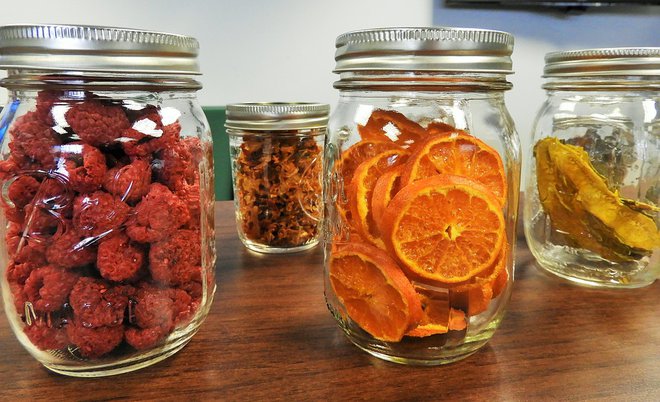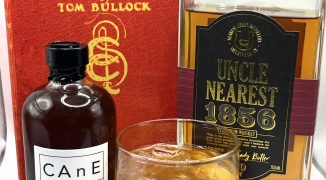When Adam Sarkis began designing the cocktail menu for The Phoenix Club, he didn’t want the bar to be like the other hotspots in downtown Milwaukee. “We’re on this block on Jefferson Street where there’s a lot of turn and burn,” Sarkis says. “A lot of bars cut mountains of lemons and limes, and you can’t reuse them the next day.”
So, Sarkis invested in a dehydrator and began drying all his lemon and lime wheels. “I wanted to offer a garnish that’s identifiable, but in a different presentation,” says Sarkis.
Sarkis has also dehydrated lime halves that have been juiced, and he’s used the dehydrated halves as vestibules for fire cocktails. He also dehydrates orange fruits after he uses the peel for cocktail garnishes. The dehydrated oranges garnish alcoholic slushies, and most customers end up eating the chewy pieces. “Your drink looks cool, and they’re pretty delicious to bite into,” Sarkis says. “Plus, when you garnish with a wedge and someone squeezes the citrus into the drink, that throws the flavors and balance off. When you dehydrate, fruits last significantly longer. You’re still throwing a lime on top of a drink, but you’re not being wasteful. You’re being mindful.”
Mindfulness — and reducing the bar/restaurant’s environmental footprint — is what the Perennial bar and restaurant in San Francisco is all about. “As a way to minimize waste, we dehydrate tons of stuff,” says Rob Hanic, bar manager. “If you chop up a lemon or a lime, it’s only good for a day or two. If you dehydrate them, they last indefinitely.”
Besides citrus fruits, Hanic dehydrates berries, tomatoes, beets, mushrooms, artichokes, squash, yams, celery…you name it, he’s probably dried it. He’s currently working on developing a Bloody Mary using dehydrated tomato and celery that’s been ground into a powder. “When it comes to vegetables, we mostly make them into powders,” Hanic says, explaining how his staff grinds them into powders using mortars and pestles. Right now, he’s using yam and squash powders for a pumpkin milk punch.

SF’s Perennial makes their Pumpkin Milk Punch with dried yams and squash.
“The main reason we do it is to reduce our carbon footprint, but it certainly affects the bottom line. We spend a lot less on citrus, and it also reduces our workload. We cut garnishes once a month instead of every day,” he says.
The Perennial uses four Excalibur dehydrators, and when they’re filled, the ovens are also turned to low temperatures to dry foods, too.
Clair Sprouse, bar manager at Sunday in Brooklyn, likes to use powders to create flavored salts for drinks. Her pastry chef suggested she dry leftover peach peels after using the peach fruit for a drink. She dried the peels, ground them into a powder and mixed that with salt. “It adds a pop of stone fruit to drinks,” Sprouse says.
Sprouse also takes discarded lime halves that have been juiced, and she dries them at 119 degrees Fahrenheit for three days until they turn black. They’re then ground into a powder to add a smoky, citrus flavor to drinks. “You’re adding a citrus element to a drink without having to add citrus at all,” Sprouse says. “When you dehydrate something, it concentrates the flavors and aromas.”
 Bartender Trevor Schneider recommends flavoring dehydrated fruits — like adding chili powder to mango slices, which he uses to garnish a drink called The Little Devil.
Bartender Trevor Schneider recommends flavoring dehydrated fruits — like adding chili powder to mango slices, which he uses to garnish a drink called The Little Devil.
Sprouse has also dried strawberries that were used to infuse Aperol. “We strained the strawberries off, dried them, and ground them into a powder. Then we used that powder to dust the top of a crushed ice cocktail,” Sprouse says. “It had this great, strawberry aroma.”
Trevor Schneider, Reyka vodka national brand ambassador, adds that bartenders who are just beginning to dry fruits and vegetables should be aware of the shrinkage in size, as they reduce to sometimes a fourth or less of the size of the original. He also recommends flavoring dehydrated fruits — like adding chili powder to mango slices, which he uses to garnish a drink called The Little Devil.
“Cinnamon and cloves can also be added to dehydrated apple chips,” Schneider says. “With apples, make sure you soak them in citrus before drying because otherwise they brown. The key with garnishes is to taste it with your eyes first to make sure it is aesthetically pleasing.”
Schneider says he’s dried starfruit, and he’s dried berries, too. “Dehydrated strawberries are great for Valentine’s Day because they look like lips,” he says.
The Little Devil
- 2 oz. Reyka Vodka
- 0.75 oz. lemon juice
- 0.75 oz. maple syrup
- 0.75 oz. Ancho Reyes chile liqueur
- Top with club soda
- Garnish with chili-dusted dehydrated mango
Pumpkin Milk Punch
- 750 ml. Four Roses Yellow label bourbon
- 750 ml. Tariquet VSOP Armagnac
- 375 ml. Batavia Arrack
- 750 g. ground, dehydrated yam
- Juice of 4 oranges
- Zest of 4 oranges
- Juice of 2 lemons
- Zest of 2lemons
- 5 cloves
- 4 3-inch cinnamon sticks
Directions: Add all ingredients to a non-reactive container and allow to infuse to for at least 2 days at room temperature, until mixture smells and tastes like pumpkin. Strain through Chinois lined with cheesecloth.
Syrup
- 1/2 lb. sugar
- 1.5 cups water
- 4 cinnamon sticks
- 1 Tsp ground nutmeg
- .5 tsp ground ginger
- .5 tsp ground clove
- 3 tbsp ground, dehydrated Delicata squash
Directions: Heat water and sugar together over medium-high, stirring regularly until sugar is dissolved. Add all ingredients and cook for 5 mins, stirring frequently. Cover, remove from heat, and allow to sit 30 mins. Transfer all to Cambro and allow to sit overnight. The next day, strain through Chinois.
Allspice cream
- 2 oz heavy cream
- 1 oz. Allspice dram
- .5 tsp. Turbinado sugar
Directions: Add all ingredients to tin and shake until cream is thickened. Final Steps: Juice 2 lemons and add to strained booze infusion. Heat 1 qt of whole milk to 140 degrees, and add to booze. Allow to stand undisturbed for about 30 mins, until milk has separated and curds float to the top. Gently skim solids off the top, and strain remaining through chinois lined with wet cheesecloth. Add syrup and refrigerate for at least 2 days, until all solids have completely settled at the bottom. Rack off solids and bottle. Store refrigerated and pour to order. Float allspice cream on top.





